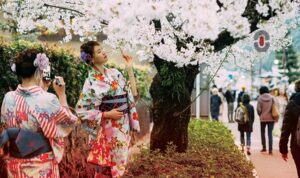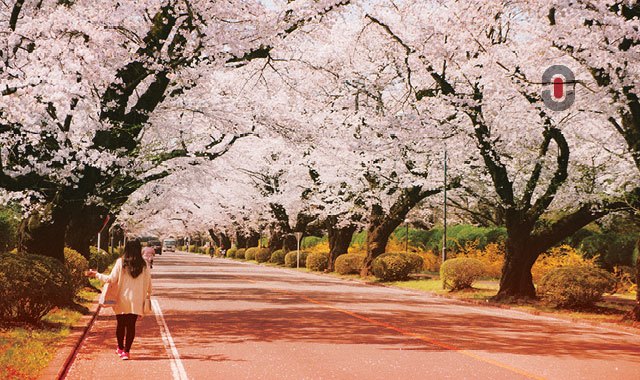From the 29th of April to the 5th of May each year, Japan and its citizens celebrate “Golden Week”. This period of festivities includes four very special holidays, which we take a look at below. But if you’re wondering why it’s been called “Golden”, you’ll find the answers not in some ancient history textbook of centuries gone by, but rather in the very last 20th century. Here’s what happened: Japan’s 1947 Constitution created a series of holidays that led many people around the country to spend their time frequenting movie theaters. Film studio Daiei’s Managing Director at the time was Hideo Matsuyama, who called this time of the year “Golden Week” mirroring the “golden” or “prime time” radio spots that had gained popularity. As a result, Golden Week continues to be celebrated in Japan until today, and it is not only the film industry that sees a boom in ticket sales but also leisure activities such as travel. In fact, Travel Voice Japan estimated that around 35% of the population traveled during the 2019 edition of this holiday period. Now let’s take a look at what these four holidays are and what specifically they celebrate.
Shōwa Day
Held on the 29th of April each year, Shōwa Day celebrates and honors the birthday of Emperor Shōwa (Hirohito), who died on the 7th of January, 1989. Interesting to note is that he reigned for a whopping 63-year period spanning from 1926 until 1989. In Japanese, Shō means “shining” or “bright” whereas “wa” means “peace”. Therefore, the purpose of this holiday essentially is for citizens to receive “enlightened peace” by encouraging them to reflect on the Emperor’s turbulent reign as opposed to glorifying the Emperor. Some notable developments to note during his rule include the end of the “Taishō Democracy, the 1931 Japanese invasion of Manchuria, a period of “government by assassination”, the rise of the totalitarian Taisei Yokusankai, World War II, the post-war occupation, the 1964 Summer Olympics and Paralympics in Tokyo, the North Korean abductions of Japanese citizens, and the Japanese post-war economic miracle.”
Constitution Memorial Day
Also known as Kenpō Kinenbi, this national holiday takes place on the 3rd of May each year to celebrate the country’s 1947 Constitution, which came into effect on that date. The post-war period was a turbulent time for Japan after the bombings of Hiroshima and Nagasaki in 1945 when the Showa Emperor declared Japan’s unconditional surrender to the allied forces. Then, over the next two years, “Japan and US General Douglas MacArthur cooperated in drafting the new constitution.” It was ratified by the House of Representatives on the 24th of August 1946, the House of Peers on the 6th of October, and by the Privy Council on the 29th of October. It was finally promulgated by the Emperor on the 3rd of November 1946 and came into effect on the 3rd of May 1947. This day is typically a reflection by Japanese citizens on the meaning of democracy and the Japanese government, where for example, Article 9 of the Constitution declares the country to be a “pacifist nation”. One way that citizens can reflect and reminisce on history is through the opening of the National Diet for public tours every year on this day.
Greenery Day
 Midori no Hi or Greenery Day and is held on the 4th of May. The celebration stems from the celebration of Emperor Hirohito’s birthday on the 29th of April each year as part of Golden Week in Japan. However, after the Emperor’s death in 1989 and Emperor Akihito ascended to the Chrysanthemum Throne, the holiday’s name changed from the Emperor’s Birthday to Greenery Day. So, what is celebrated during this day? As you can guess, it’s anything to do with nature. It involves being thankful for the blessings and bounties that nature bestows on us.
Midori no Hi or Greenery Day and is held on the 4th of May. The celebration stems from the celebration of Emperor Hirohito’s birthday on the 29th of April each year as part of Golden Week in Japan. However, after the Emperor’s death in 1989 and Emperor Akihito ascended to the Chrysanthemum Throne, the holiday’s name changed from the Emperor’s Birthday to Greenery Day. So, what is celebrated during this day? As you can guess, it’s anything to do with nature. It involves being thankful for the blessings and bounties that nature bestows on us.
Children’s Day
The last holiday of the Golden Week is Children’s Day or Kodomo no Hi and it takes place on the 5th of May. Although this holiday has been celebrated in Japan since ancient times, it became official in 1948. This special day seeks to set aside time to reflect on children’s happiness as well as their developing personalities. What you may not know about this special holiday is that this day was originally called Tango no sekku. It is also interesting to note that this holiday was also known as Boys’ Day or the Feast of Banners, which recognized sons and their fathers. There was also a Girls’ Day although this was celebrated on the 3rd of March. However, in 1948 all this changed and Children’s Day was celebrated for both male and female offspring, together with the recognition of mothers and fathers and the unity of the family system.
So, how is this holiday celebrated? Many families around Japan raise carp-shaped windsocks to blow in the wind. When they do so it looks like they are swimming and this goes back to an old Chinese legend that a carp that swims upstream will become a dragon and then fly to Heaven. There are also color allocations for each carp: black for the father, red/pink for the mother, and blue/green/orange for every child. To end this celebration, kashiwa mochi is usually served. These are sticky rice cakes filled with red bean paste and wrapped in sweet oak (kashiwa) leaves. However, the leaf is not eaten, instead, it is a symbol of prosperity.
Enjoy The Golden Week In Japan!
If you find yourself in Japan towards the end of April and the beginning of May, you may just find yourself in a very festive atmosphere with many families celebrating the rich history and ancient customs of the country. From Shōwa Day to Constitution Memorial Day, which is on the more serious side of reflections to Greenery Day and Children’s Day, which are more nature and family-oriented, there’s a little bit for everyone during Golden Week in Japan.
